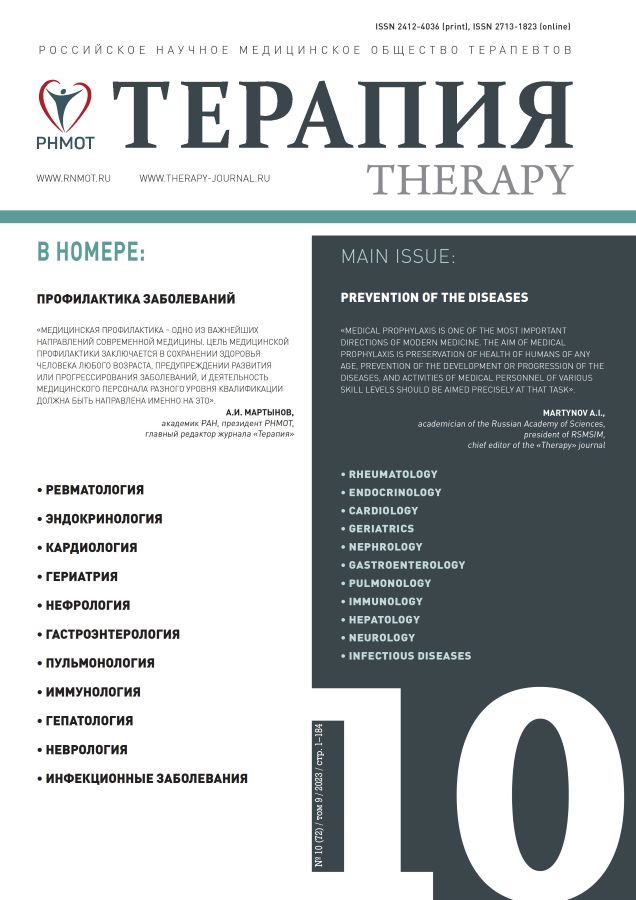Epidemiology of atherosclerotic cardiovascular diseases in some regions of the Russian Federation, clinical characteristics of patients and estimation of the efficacy of lipid-lowing therapy: study of real clinical practice
- Authors: Tuaeva I.B.1, Astakhova Z.T.1
-
Affiliations:
- North Ossetian Medical Academy of the Ministry of Healthcare of Russia
- Issue: Vol 9, No 10 (2023)
- Pages: 40-47
- Section: ORIGINAL STUDIES
- URL: https://journals.eco-vector.com/2412-4036/article/view/626265
- DOI: https://doi.org/10.18565/therapy.2023.10.40–47
- ID: 626265
Cite item
Abstract
Atherosclerotic cardiovascular diseases (ASCVD) are traditionally leading in the structure of mortality in the world and in Russia.
The aim of the research is estimation of the incidence of ASCVD from 2016 to 2021 in the general population and by strata (acute/chronic ASCVD, age, gender), prevalence of these diseases by years; comparison of demographic and clinical characteristics of patients with and without ASCVD; study of applied lipid-lowering therapy regimens and its efficacy in clinical practice.
Material and methods. The source of data for the study were anonymized medical records from the EHR of patients in healthcare facilities for the period from 01/01/2016 to 02/28/2022 in 10 territorial entities of the Russian Federation. ICD-10 codes were used to identify patient subgroups (acute/chronic ASCVD). Epidemiological part of the research for study the incidence and prevalence of ASCVD in the Russian Federation for the period 2016–2021 included 1,591,126 patients from the Kirov region; clinical part of the research for study the efficacy of lipid-lowering therapy regimens for ASCVD included 293,803 patients from 10 territorial entities of the Russian Federation.
Results. Among all patients included in the epidemiological part of the study, only 14,1% were diagnosed with ASCVD. The group of ASCVD patients differed significantly from the group without ASCVD in age parameters: 68,5±12,1 versus 41,9±23,9 years old. The initial level of LDL cholesterol on statin monotherapy was 3,27±1,18 mmol/l. No significant dynamics of this index was found in patients with ASCVD during lipid-lowering therapy after 3–6 (2,93±1,16 mmol/l) and 6–12 (2,96±1,08 mmol/l) months. In the statin monotherapy group, the proportion of patients who did not achieve the target LDL cholesterol level <1,4 mmol/l after 3–6 months was 95,83%, and after 6–12 months – 96,06%. At the same time, the frequency of failure to achieve LDL cholesterol levels in the range of 1,4–1,8 mmol/l was slightly lower and after 3–6 months was 90,22%, and after 6–12 months – 91,63%. Combined lipid-lowering therapy statin + ezetimibe was prescribed in total to 52 patients with ASCVD.
Conclusion. Currently, in real clinical practice in 10 subjects of the Russian Federation, a clinical inertia in achieving target LDL cholesterol levels in ASCVD patients takes place, which requires more active implementation of innovative lipid-lowering medicaments use.
Full Text
About the authors
Irma B. Tuaeva
North Ossetian Medical Academy of the Ministry of Healthcare of Russia
Email: tuaevai@mail.ru
ORCID iD: 0000-0001-7508-645X
SPIN-code: 6459-2763
PhD in Medical Sciences, associate professor of the Department of internal medicine No. 4, North Ossetian Medical Academy of the Ministry of Healthcare of Russia
Russian Federation, VladikavkazZamira T. Astakhova
North Ossetian Medical Academy of the Ministry of Healthcare of Russia
Author for correspondence.
Email: sogma@yandex.ru
ORCID iD: 0000-0001-7299-5607
MD, professor, head of the Department of internal medicine No. 4, North Ossetian Medical Academy of the Ministry of Healthcare of Russia
Russian Federation, VladikavkazReferences
- GBD 2019 Diseases and Injuries Collaborators. Global burden of 369 diseases and injuries in 204 countries and territories, 1990–2019: A systematic analysis for the Global Burden of Disease Study 2019 [published correction appears in Lancet. 2020; 396(10262): 1562]. Lancet. 2020; 396(10258): 1204–22. https://dx.doi.org/10.1016/S0140-6736(20)30925-9.
- Roth G.A., Mensah G.A., Johnson C.O. et al. Global burden of cardiovascular diseases and risk factors, 1990–2019: Update from the GBD 2019 study [published correction appears in J Am Coll Cardiol. 2021; 77(15): 1958–59]. J Am Coll Cardiol. 2020; 76(25): 2982–3021. https://dx.doi.org/10.1016/j.jacc.2020.11.010.
- World Heart Report 2023: Confronting the world’s number one killer. Geneva, Switzerland. World Heart Federation. 2023. URL: https://world-heart-federation.org/wp-content/uploads/World-Heart-Report-2023.pdf (date of access – 01.12.2023).
- Здравоохранение в России. 2021: статистический сборник Росстата. М. 2021; 171 с. Доступ: https://rosstat.gov.ru/storage/mediabank/Zdravoohran-2021.pdf (дата обращения – 01.12.2023). [Healthcare in Russia. 2021: statistical collection of Federal State Statistics Service (Russia). Moscow. 2021; 171 pp. URL: https://rosstat.gov.ru/storage/mediabank/Zdravoohran-2021.pdf (date of access – 01.12.2023) (In Russ.)].
- Chen G., Farris M.S., Cowling T. et al. Prevalence of atherosclerotic cardiovascular disease and subsequent major adverse cardiovascular events in Alberta, Canada: A real-world evidence study. Clin Cardiol. 2021; 44(11): 1613–20. https://dx.doi.org/10.1002/clc.23732.
- Kim H., Kim S., Han S. et al. Prevalence and incidence of atherosclerotic cardiovascular disease and its risk factors in Korea: A nationwide population-based study. BMC Public Health. 2019; 19(1): 1112. https://dx.doi.org/10.1186/s12889-019-7439-0.
- Mach F., Baigent C., Catapano A.L. et al. 2019 ESC/EAS guidelines for the management of dyslipidaemias: Lipid modification to reduce cardiovascular risk [published correction appears in Eur Heart J. 2020; 41(44): 4255]. Eur Heart J. 2020; 41(1): 111–88. https://dx.doi.org/10.1093/eurheartj/ehz455.
- Ray K.K., Molemans B., Schoonen W.M. et al. EU-wide cross-sectional observational study of lipid-modifying therapy use in secondary and primary care: The DA VINCI study. Eur J Prev Cardiol. 2021; 28(11): 1279–89. https://dx.doi.org/10.1093/eurjpc/zwaa047.
- Vrablik M., Seifert B., Parkhomenko A. et al. Lipid-lowering therapy use in primary and secondary care in Central and Eastern Europe: DA VINCI observational study. Atherosclerosis. 2021; 334: 66–75. https://dx.doi.org/10.1016/j.atherosclerosis.2021.08.035.
- Brandts J., Bray S., Villa G. et al. Optimal implementation of the 2019 ESC/EAS dyslipidaemia guidelines in patients with and without atherosclerotic cardiovascular disease across Europe: A simulation based on the DA VINCI study. Lancet Reg Health Eur. 2023; 31: 100665. https://dx.doi.org/10.1016/j.lanepe.2023.100665.
- Ray K.K., Haq I., Bilitou A. et al. Treatment gaps in the implementation of LDL cholesterol control among high- and very high-risk patients in Europe between 2020 and 2021: The multinational observational SANTORINI study. Lancet Reg Health Eur. 2023; 29: 100624. https://dx.doi.org/10.1016/j.lanepe.2023.100624.
- Ference B.A., Ginsberg H.N., Graham I. et al. Low-density lipoproteins cause atherosclerotic cardiovascular disease. 1. Evidence from genetic, epidemiologic, and clinical studies. A consensus statement from the European Atherosclerosis Society Consensus Panel. Eur Heart J. 2017; 38(32): 2459–72. https://dx.doi.org/10.1093/eurheartj/ehx144.
Supplementary files








